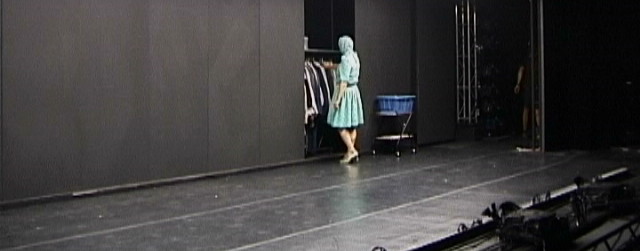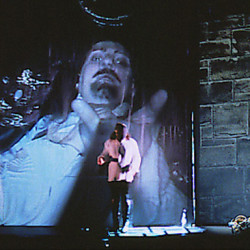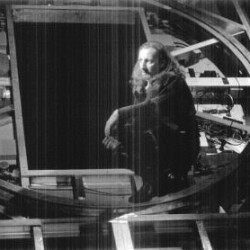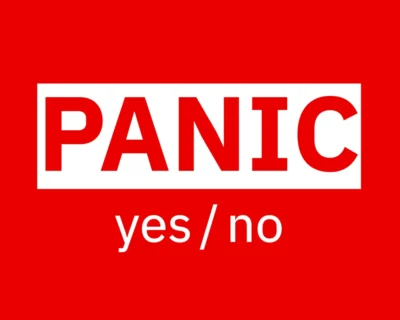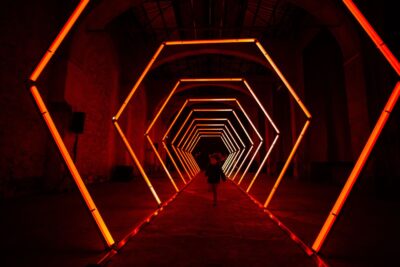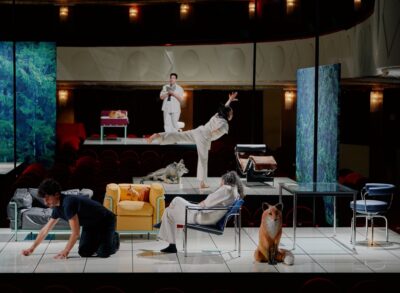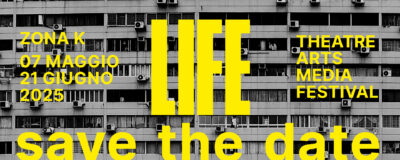Published in E. Quinz, Digital performance
Before Galileo turned his telescope toward its surface people believed the moon was a polished mirror, its dark scars and mysterious contours reflections of our mountains and seas. The Soviets launched a probe to circle the moon. We faced a far and unseen side of the moon: a marked and disfigured face by scars ‘cause of meteorite.
R. Lepage, The far side of the moon.
In the South-central District of Montréal, in the premises of the C factory (former industrial ovens transformed today into a multi-functional stage by the founding company Carbon 14), at the Festival of Theatres des Amerique (2001) Robert Lepage presented The Far Side of the Moon with an original score by Laurie Anderson, in the same year as Kubrick’s Space Odyssey.
The exploration of the moon by Americans and Russians (up to Galileo Galilei “mirror of the Earth”, as it is said in the Prologue) is the metaphor used by Lepage to speak about another search, that of the internal, intimate and private space.
It’s the story of two brothers, a meteorologist and a doctoral student (but also a subscriptions sale man always fascinated by extraterrestrial investigations). Estranged by their very different life style and dispositions, they meet again for their mother’s death. The moon and the mother, with their respective mythical and symbolic apparatus, are the spectacle’s two central theme which ceaselessly interlace. The two brothers’ life is spattered by “domestic investigations”: the circular shape of the astronauts’ helmet and that more common, of a washing machine’s window blend in a strange exchange which transforms themselves into the maternal uterus, into the image of Earth seen in Tv’s whether report, into the Moon, or also into a goldfish tank. Daily life and History, personal recollections and collective memory, both shaped by “an index” of image archives, are mingled the one with the other, until they merge. We came to the world like little astronauts who breathe for the firs time after the umbilical cord-back of the new born child, given by the midwife, thanks to which he breathes in his first oxygen blow, setting in the breathing process.
Will somebody really manage to build this enormous “Eiffel Tower” (reminiscent of Tatlin’s Monument for the third international) which, set up beyond the stratosphere, as we are told at the beginning of the spectacle, should be able to pick up what remains a secret to us: the hidden side of the Moon? Which probe will ever manage to discover the most mysterious and repressed side of our Self?
ACTOR and MIRROR
Autobiography, journey and concrete objects are the inspiring motives of this spectacle:
There are two departing points- Lepage explained to us-: the first idea was to work on the concept of the Cosmos, and of the Moon, the second was to create something related to my mother, who died two years and a half ago. The two themes didn’t seem to be linked at first, but met little by little: the moon is a rich and interesting subject, either for mythology and for the scientific aspect, but mostly it is the symbol of the Mother. It is then that I understood that the first subject could contain the other one.
Then, I wanted “to play” not only in the sense to interpret, but really to play as a child; I looked for the object capable of creating a link between the various themes and one day I found in the street, among waste, the circular window of a washing machine. At first I saw the scientific aspect (the object to travel in space), then the common object . I still remember a laundry where my mother had taken me when I was a kid. At the time it had seemed to be Nasa’s power plant”[1]
The autobiographical theme, as an embryo for theatrical creation, seems to be constantly present in Lepage’s solo spectacles (Vinci, Les aiguilles et l’opium, Elsinore, Andersen Project). The chosen method to create the right distance with the particular episode (moral questions, the loss of a friend or a mother, a love crisis) and, at the same time maintain this background of authenticity and transform a confession into fragments of collective memory and experience, is the creation of a couple of characters bound to each other in different ways. The central autobiographical figure is linked to a character who actually is not really an antagonist an alter ego (also present under the shape of an electronic double), a living mirror which sometimes takes the role of a famous historical figure (Leonardo, Cocteau, Miles Davis, Andersen).
The unfolding of the spectacles always shows, not the contrast among the various personality but the simultaneity of an internal individual conflict and an identity with multiple and complex facets, of a platonic dialectic of opposites: “Fragmentation of identity allows Lepage to balance person and character in a complex negotiation of self and other in which neither takes precedence”[2].
The double or the multiple binary of the narrative becomes a complex theatrical mechanism since the show is conceived for a single actor on stage; it is the story’s role then to evoke the spectre of technology. Image-producing technology machines, the electronic apparatuses, panels, screens, are always, indeed, metaphor of a glance, internal or multiplied, and intervene to show the repressed, the hidden side of reality, exactly as the characters, historical or imagined, called to plead as witness-antagonists, are nothing but projections (mirrors or reflections) of an internal self, manifestly divided and literally broken in two, which calls for its own existence: “I used to look for my reflection in his courage, he was my mirror and today he is dead”; this is how Philippe, the protagonist of Vinci speaks about his friend Marc, who has committed suicide.
If in The Far Side of the Moon the characters-mirrors are the two brothers, united in amniotic liquid and by the mother’s umbilical cord, but separated in life; in Les aiguilles et l’opium, it is the protagonist who relives his own love drama (suffered as an abstinence crisis) following the model of well known stories of dependencies (Cocteau), of passions and separations (Miles Davis and Juliette Gréco). In Vinci the protagonist, a Canadian photographer, arriving in Europe after the death of a friend, makes a journey on Da Vinci’s grounds and finds himself confronted with the genius of humanism by raising questions relative to his own “artistic and moral integrity to protect it from profit-making mentality”: “An artist like you, who has inspired by the beauty of things, who loathed human suffering and feared cataclysm –how do you explain that you invented war machines, engines of destruction?” And Da Vinci answers with a sibylline sentence “Art is a paradox”.
THE ACTOR AND THE MACHINE: Elsinore and The Far Side of the Moon
Elsinore, is a spectacle conceived for a single actor on stage, is based on a single place, Elsinore and it is the exploration of Hamlet’s mind: all the characters – as Lepage himself clarifies- are parts or interior projection of his same Self; they are places in his mind: “The father the ear, the mother the eyes, the actors the mouth”.
In 1913 Edward Gordon Craig had thought of representing Hamlet in Moscow (in collaboration with Stanislawsky) as a “mono-dama”, that is to say a tragedy lived as a dream through the eyes of the protagonist, Hamlet; in the scenic indication which illustrates the drawing concerning Act 1, scene 2 (The Gold Court, included in his book Towards a new Theatre) where Hamlet is shown separated from the reigning couple and court thanks to a balustrade, lying in a sacrificial position and in the shadow, Craig explains that all the drama’ characters are only projections of Hamlet’s own imagination. According to Craig in his dream Hamlet materializes all around and over him the court of Denmark, the place of all impiety, exactly as it appears to his eyes:
“You see the stage divided by a barrier. On the one side sits Hamlet, fallen as it were into a dream, on the other side you see his dream, on the other side you see his dream. You see it as it were through the mind’s eye of Hamlet (…). It’s not an actual thing –it’s a vision”[3].
To further underline the dynamics of the action, Craig manages to intervene in a decisive manner on the text, showing how it is necessary to think of the drama in its entirety to introduce the idea –which it wasn’t realized – expressed to Stanislawsky during a study day in Moscow, to keep Hamlet on stage always:
“I would like Hamlet to always remain on stage, in every frame, during all the drama; he can remain on stage, in every frame, during all the drama; he can remain far, lying down, sitting facing the person acting, on the side, at the back but the spectator should never lose sight of him. I want the public to feel the existing contact between what is happening on stage and Hamlet: and in that way to feel, more strongly, the horror of Hamlet’s situations”.
For Lepage a single scenic element through a mobile device holding multiple possibilities of movement and through the relation which it establishes with the character that lives inside its mechanisms, shows this indivisible and opposite polarity. Its only attribute is the ability to transform, its attitude is the mutability.
“The combination of the moving set, continually creating new relationships between the performer and the space and the depiction of a range of backstage areas configures a number of the play’s themes. Elsinore is about instability, about a whirly of activity around a central figure, about continual tensions between a human figure and a piece of machinery which one could express, metaphorically as a tension between individual and state or even the human and the cosmic”[4].
Elsinore is the place, at the same time, physical and mental of the tragedy, at the centre of which is placed Hamlet, forced to stay in-between, to live separately-close to the corrupt court, relegated to an impossibility of free movement, while the scene ceaselessly moves around him (and not the contrary). All the characters in one, all the places in one: this scene machine (“humanized” as the stage designer Carl Fillon likes to define it[5]), subject to variations and changes, a true theatrical mask, takes expressions, faces and different personalities, transforms constantly. If all the scenes have been built as a basis for the movement of the scenic device itself, the actor is forced to follow its rhythm, its breath. He can cross it, remain suspended, lean on it and thus create a relation of symbiotic complicity. He can have a dialogue with it, and find some protection in it but also dangers between its cogs; a reversal of roles definitely takes place: the machine which has crushed its last artificial determinism to become a body, is the true protagonist and the actor a kind of “actorial supermarionette”, is the spare part. If the machine is humanized, the actor becomes a machine: “For me –Lepage explains- he machinery is in the actor, in his way of saying the text , of approaching acting: there is a mechanics in there also”. And also: “I tell stories with machines. The actor himself is a machine: I know that several actors do not like being spoken of as being machines but when you make theatre, it’s little like that” [6]. Craig’s prediction seems to turn out right.
But in Elsinore the theatrical machine is also the X-ray machine which penetrates into the meanders of Hamlet’s thoughts, and carries to his consciousness recollections and truths in the shape of images and which, as Horace, will tell his story. The technological theatrical machine becomes a lie detector, that is to say –like the title of one of the most famous Lepage’s spectacle- a polygraphe: theatre is the place where the true is revealed.
The far side of the moon is, by certain aspects, the closest to Elsinore’s universe. Lepage creates, in fact a dark grey metal background which occupies all the depth of the stage, and which hides environments split by sliding panels; on its surface some images are projected which are extracted from documentaries on the moon’s discovery, super-8 films of the character’s life (memory as a television images store).
An opening in the middle, shows a glimpse of always different objects and environments: a cupboard, an elevator, rooms. Interiors.
To this background also corresponds a fourth physical wall: an enormous mirror which extends on all the length of the stage endowed with movements of rotation which transform it, either into an object of the stage, or into a reflecting ceiling, giving to the spectators, while the actor is moving at the ground, the impression of a duplicated body engaged in dance almost in absence of any gravity. Like the screens of the “kinetic-visual” theatre of Gordon Craig (defined “the thousand scenes in one”) which allowed several combinations and variations adapting scenic environments to the requirements of the drama and partially realized for the Moscow Hamlet of 1913, the stage of Lepage’s mobile face transforms thanks to movement and light:
“The theatre is the art of transformation at all levels. Transformation becomes not a manner, but really the actual foundation of my work”[7].
The setting of the spectacle requires three complete working days and a team of fourteen people. The used mechanism makes one think of the old mechanisms and machinery (“ingenii”) of the Renaissance theatre, the time of invention of mobile stages and a true mixture of marvels and ars mecanica (remembering Vasari’s stage and the Buontalenti’s inventions for the Theatre of Uffizi in Florence).
Everything occurs as if there was another spectacle behind the spectacle: technicians and sound and light engineers, but also numerous “manipulators”, activating, behind the stage slaves move panels, set up the scenic arsenal and steer projectors by the means of ropes. As if they were activating a marionette. To explain the importance of the backstage, Lepage refers to Japan:
The first time I assembled a show, I played an improvisation in front of the technicians and machinists. The technician is the first co-worked and the first spectator. When I was in Tokyo, a person said to me that he worked in the “shadowy part” of the show; he explained to me that the Japanese theatre is a matter of balance between the light part and the shadowy part of the show because there are two sides of the same medal. The Japanese is aware of the fact that theatre is a totality and that what takes place behind, at the level of technique or organization, has the same importance as what takes place on stage. Occidental theatre, on the contrary, is obsessed by the visible part of the scene, by the stage alone.
The essence of Lepage’s theatre is a metamorphic stage, which transforms ceaselessly, and becomes all that the narration needs to develop and this, in all visibility to the spectators: technology is unmasked, its functioning is at sight because, as Lepage says “People are not worried by the technology which they understand”. And also: “Video has become totally domestic and common, one can thus uses it on stage. The principle is understood and, as a result, the spectators accept that technology can contain poetry”[8].
A technology, therefore, which does not want to arouse bewilderment, which doesn’t want to amaze the spectator but, on the contrary, reassure him: its use on stage always implies in fact, an effort of collaboration and creation between the two parts of the game (it is the purpose of theatre). Here we have in synthesis the idea of integrated technology according to Lepage: “You still have to give a lot of leeway to the audience’s imagination”; and furthermore:
A lot of the technologies I use in my show are low tech, although they may look high tech. There are three slide projector, a bit of shadow play, and that it is. There is nothing else. There is a motor that makes the thing goes round, there is nothing originally high tech in any of the effects it produces, but may be it’s a god thing it looks like high tech, because it means you can actually do a lot with very little. There’s nothing that electronic about it…For me that is an interesting technology to let into the theatre now because people now know how it works. Fifteen, twenty years ago, when people did not have access to video camera, they would have been flabbergasted to see a production using video in this way. You put people in a very empowered position if you don’t show them the strings or give them the clues to your approach[9].
Lepage mentions Osaka’s traditional Japanese puppet theatre (the bunraku theatre) where the oldest of the three manipulators removes his hood and show his own face, giving thus a show of his own masterful manual ability (a special manner of manoeuvring puppet introduced in 1705 by the famous Tastumastu Hachirobei, and called de-zukai). So, in spite of his detractors (some critics spoke of an over use of technologies in his theatre) Lepage’s stage is always closer to the mechanical. His machine, as reminds the theatre critic Georges Banu, “is structured like an old tool: it doesn’t charm at all, dispute current technological performances and it does not belong to the extreme-contemporary as long as its devices and circuits makes the show not infallible and allow the hypothesis of the incident to stay open”[10] (which it could insure –if one follows Benjamin- a value of presence, aura and originality). Elsinore has known numerous technical inconveniences: at the Edinburgh Festival was necessary to suspend its programming.“A show –reminds Lepage –has to contain risks”.
- Elsinore
The theatre and the fire.
Lepage speaks of light and its opposite, shadow as fundamental constituents of his stage; his definition is partially inspired by Leonardo Da Vinci’s theory of art and partially by Japanese Theatre:
Every year, since the XV-th century, the Japanese inaugurate the NO Theater Festivals with light spectacles at night and they use fires to illuminate the stage. Even if you consider it shape of art or a form of entertainment, the purpose is to celebrate light.
We owe the first apparition of Theatre in History, to the light, as Lepage reminds:
Technology is the re-inventation of fire. At the beginning of Theatre, lots of centuries ago, the actor spoke with the spectator in front of the fire and with his shadow behind. Fire is a natural element but its use marks the beginning of technology and at the same time, the beginning of Theatre: afterward, all the various uses of fire are became painting, cinema, video…Fire was replaced by technology, it supplies electricity but people still come to the theatre to sit down around the fire. People want to assemble and listen to stories: it is the same thing today as centuries ago. It is the same philosophy: every time I have to re-invent the use of fire.
With this sentence Lepage leads reflection to an anthropological dimension, and posits technology in a close relation to the concept of theatrical communities, which bring us as Victor Turner wrote, to reconsider the birth of the theatre from rite, from the “social drama” and from the oral world.
“The paideia of orality –underlined the Italian philosopher Carlo Sini- favoured a high identification with the tale. It was necessary to take position in favour of Achilles or Hector; there was no place for a neutral attitude and even less for an aesthetic listening. Oral memory and its creativity are collective phenomena”[11]. The question aroused by this enhanced theatre is bound to a kind of perception and participation and sharing the theatrical event with the audience, which technology itself seeks: “People want direct life, three dimensional interaction, and that’s something that belongs
[1] Robert Lepage interview by Anna Maria Monteverdi, Montréal 6 June 2001. Direct speeches and quotations must be considered as being a part of this conversation. The interview is a part of the videodocumentary La faccia nascosta del teatro (by Anna Maria Monteverdi and Giacomo Verde, 2002) and is included in A.M.Monteverdi, Il teatro di Robert Lepage, Pisa, Biblioteca Franco Serantini Editori, 2004. For more information see: www.ateatro.it
[2] J. Bunzli, Autobiography in the house of mirrors: the paradox of identity reflected in the solo show of Robert Lepage, in J. Koustas, J. Donohoe, Theater sans frontieres, Michigan State University, 2001.
[3]E.G.Craig, Towards a new Theatre, London, 1913;
[4] A.Lavender, Hamlet in Pieces, New York, 2001
[5] Cf. Carl Fillon interviewed by Anna Maria Monteverdi in About Elsinore, a videodocumentary about the setting of Elsinore (2002).
[6]R.Lepage “Le Devoir”, 16 Nov., 1995
[7] R.Charest, Connecting Flight, London, TCG, 1999, p. 161
[8] R.Lepage, Histories paralleles “Les Inrockuptibles”, n.77, nov. 1996
[9] R.Lepage in conversation with R.Eyer; on line: http://nt-online.org/platforms/robertlepage.html
[10] G. Banu, Theatre et technologies ou Celui qui dit oui/ Celui qui dit non in « Cahier du Theatre Jeu », n. 90, 1999
[11] C.Sini, Filosofia e scrittura, Bari, Laterza, 1994, p.29

